How cattle on herbal leys have transformed Essex farm
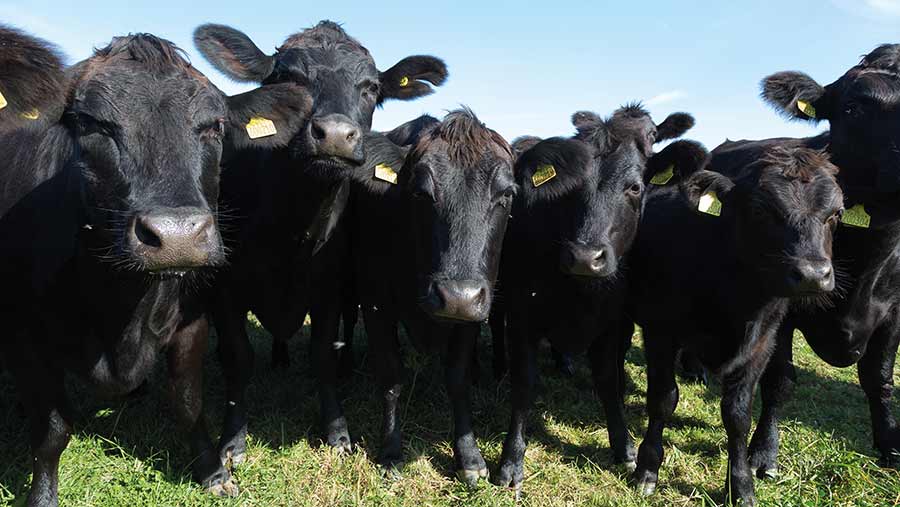 © MAG/Judith Tooth
© MAG/Judith Tooth A short video about grazing herbal leys sparked a complete change of direction for an Essex arable farm.
Gone are the wheat, oilseed rape and potato crops, and in their place are suckler cattle, with beef sold at the farm gate and online.
Soils have improved rapidly at Humphrey’s Farm since moving to herbal leys.
Levels of pH have dropped from alkaline to neutral, organic matter is up to 6.5-7.5% from 3.5-4% and worm counts are up threefold to 450/sq m across the 81ha (200-acre) farm.
See also: Why dairy beef is set to beat arable returns
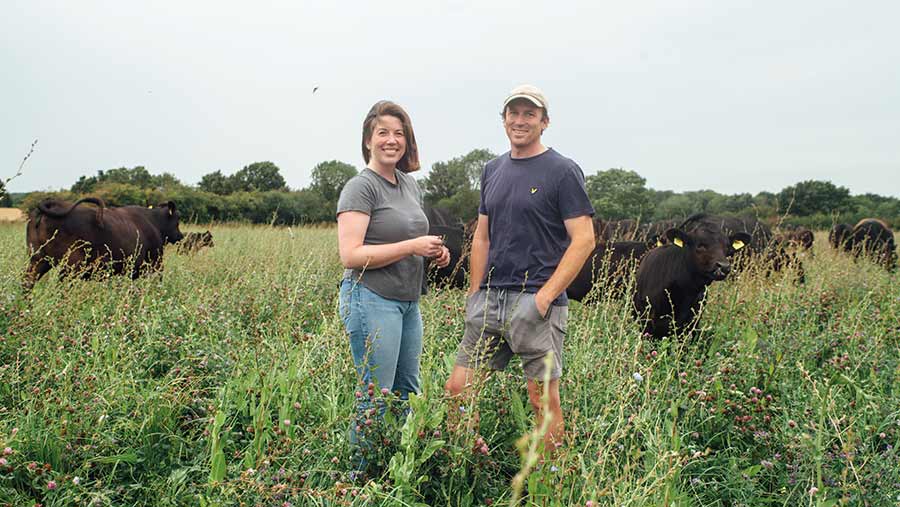
Kate and Sam Squier © Jacob McDowell
Farm facts
Humphrey’s Farm, Great Waltham, Essex
- 81ha
- Loamy clay soils with underlying chalk
- 50 native Aberdeen Angus and Wagyu breeding females, with progeny retained for breeding or finished on farm
- Sell beef direct and online
- Rotational grazing on herbal leys
- Certified by Pasture for Life
- 6,000 breeder turkeys producing 20,000 fertile turkey eggs/week in season
- Rears 20,000 free-range turkeys for Christmas
Now, Sam Squier, a third-generation tenant farmer near Chelmsford, has won this year’s VetPartners’ Sustainable Beef Farmer award.
Sam took over the running of Humphrey’s Farm 20 years ago. He continued the farm’s arable rotation, producing respectable yields despite growing evidence of soil compaction.
He also bought some suckler cows, which would graze the river meadows around Chelmsford in the summer months.
With numbers growing, he decided to introduce grass into the arable rotation and was about to buy seed for a two-year silage ley when his eye was caught by a video about running livestock on herbal leys.
Switch from arable
“The idea resonated – my father and grandfather had always talked about worms and the importance of muck – so instead of buying the intensive grass seed, I bought seed for 20 acres [8ha] of herbal leys,” says Sam.
By 2018, herbal leys had replaced arable cropping entirely under a Countryside Stewardship (CS) scheme, with grant-funded fencing and water infrastructure in place for grazing livestock.
“As a small farm, getting £23,000/year to grow herbal leys made the switch from arable very attractive financially – and at that time we were getting direct payments as well,” he says.
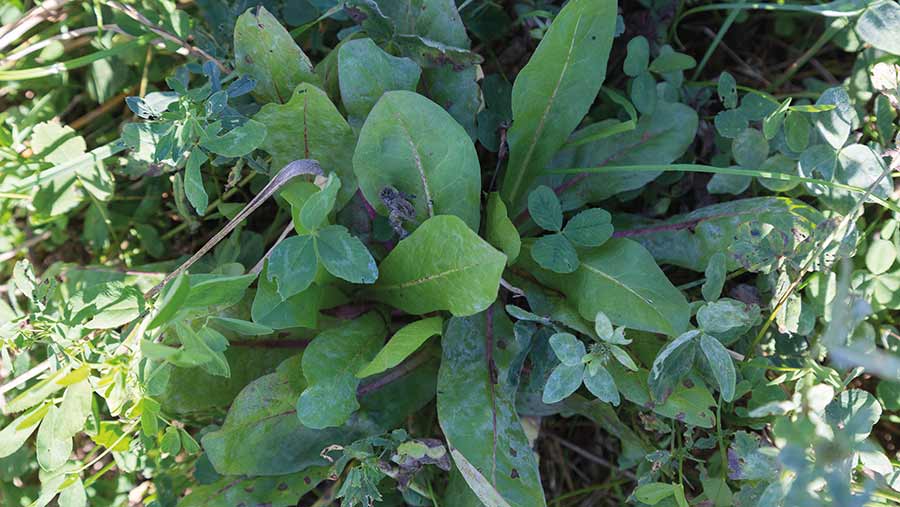
Herbal ley © MAG/Judith Tooth
However, the change of system got off to a shaky start. Progress was delayed by a very dry spring in 2019 and, at the same time, the farm was “massively understocked” after some cows had been sold to provide a deposit for a house.
Things fell into place when Sam booked a 12-day holistic management training course with 3LM, part of the Savory Network, at FarmED in the Cotswolds.
“It was a turning point for me in how I looked at what I should be doing as a land manager and gave me the confidence to say: I am holistically managing herbal leys using cattle and time as tools.”
Grazing system
Density of mob-grazing changes throughout the growing season depending on conditions, to ensure cattle maintain a non-selective eating habit and soil is protected from damage.
“Four years in and every year has been completely and utterly different. But I’m building a comprehensive idea of what should be done.
“We’re grazing the whole farm about four times a year now and we’ve extended the grazing season by three weeks in three years, mostly at the end of the year,” says Sam.
He expects to increase that by another two weeks in the coming years.
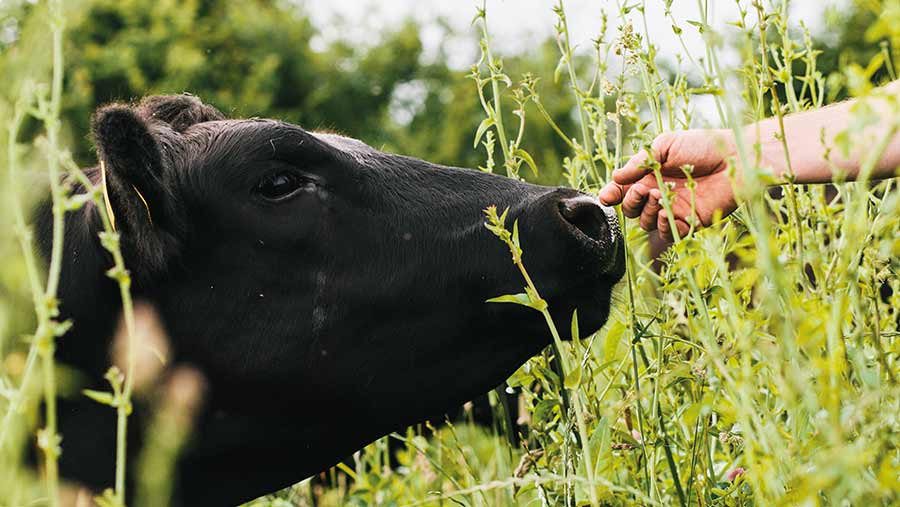
© Jacob McDowell
A further 26ha (65 acres) have been taken on: 14ha (35 acres) are herbal leys on a neighbouring farm and 12ha (30 acres) of a red clover/ryegrass mix on an arable farm.
An annual silage cut is taken from each to provide winter feed for the cattle.
Beef production
The suckler herd – 50 cows and followers – is a mix of Aberdeen Angus and Wagyu.
There are two calving blocks, in spring and autumn, to provide a more regular supply of beef for the farm’s direct and online sales.
These are sold under the Wild and Rooted Farming brand, set up by Sam’s wife, Kate.
Pure Angus cows are put to a Wagyu bull and the resulting females are then crossed to a beefy Aberdeen Angus.
This three-way cross is producing average growth rates of 1.7kg/day off herbal leys, with very well-marbled meat, says Sam. Cattle are finished without any concentrates.
A finished animal costs about £650 to rear. Sold direct, it will average £4,500 in retail sales, with local butchering and packaging costs set against this. Selling a finished animal through the abattoir will make £1,500.
“We can finish at 18-19 months – herbal leys are like rocket fuel – but we kill at 29 months for our private customers, to improve eating quality and marbling.
“We haven’t sold finished animals to the abattoir for two years.
However, if prices and demand stay strong, and with a horrendous electricity bill, next year we will focus on finishing for our local abattoir [C Humphrey & Sons], with just a few kept back for our customers.”
Winter housing is in a modern building with locking yokes, which are “a godsend for artificial insemination, as the cows are used to using them for feeding, and they are a massive improvement on using a crush”.
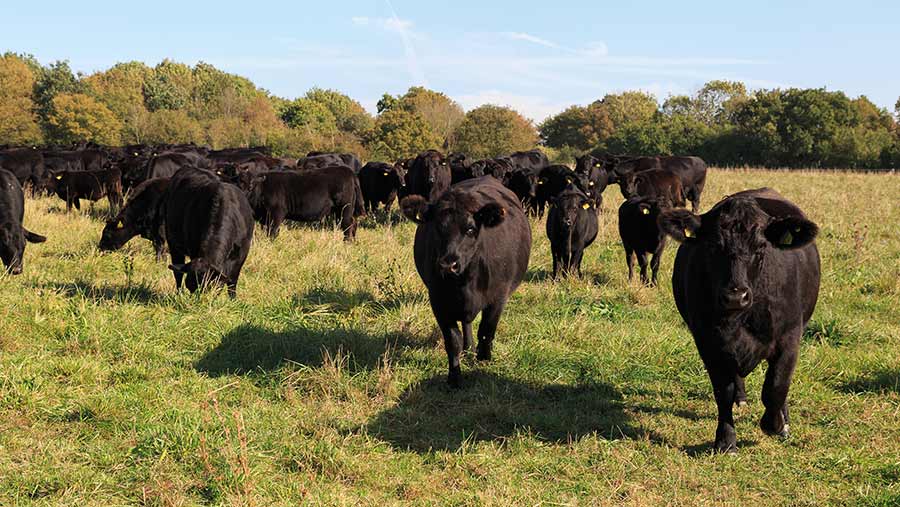
© MAG/Judith Tooth
Animal health
Faecal egg counts are taken in the autumn to check for any worm burden.
For the past eight years, these have shown no eggs, so no worming has been done. If any were found, Sam says he would monitor the situation for a year.
“If there was an animal health problem, I wouldn’t rely on herbal leys to fix it, but I’m a strong believer that once you have built up healthy soils and you’re grazing herbal leys, animals will be getting a much better diet with nutritional elements that will help maintain health,” says Sam.
“We’re discussing health schemes with our vets – I’d like to be able to sell Pasture for Life-certified breeding females, but there is a cost to that, so I’m weighing up the benefits. For now, we’re focusing on retail meat sales.”
Vet perspective
Sam Squier’s mindset was what impressed Mia Ellis of Westpoint Farm Vets, Chelmsford, the most when she nominated him for VetPartners’ Sustainable Beef Farmer award.
“He’s very open to new ideas and really wants to learn and improve.
A lot of thought has gone into how he runs his cattle. Mob-grazing works well on his farm to break the parasite cycle,” she says.
Careful breeding decisions, such as selecting for fly resistance, also add to his sustainability credentials.
“So many people buy animals and just expect them to be OK, whereas when you have a suckler herd and you’re breeding the next generation, you need to think about what animals would do well in your system to increase longevity and resilience.”
Mia thinks Sam was “really brave” to completely change his farming system, and especially in Essex, where livestock farmers are so isolated.
“It takes tenacity to do that, and to make a success of it is very impressive,” she says.